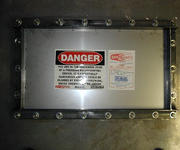
Explosion vent
Encyclopedia

Vent
Vent may refer to:*Vent , a slit up the back of a jacket or coat*Vent , a valve fitted to the top of a submarine's ballast tanks*Vent , a 2001 album by Caliban...
will relieve pressure
Pressure
Pressure is the force per unit area applied in a direction perpendicular to the surface of an object. Gauge pressure is the pressure relative to the local atmospheric or ambient pressure.- Definition :...
from the instant its opening (or activation) pressure pstat has been exceeded.
Several explosion vent panels can be installed on the same process vessel to be protected. Explosion vents are available in the versions self-destructive, non-self-re-closing and re-usable, self-re-closing.

Inertia
Inertia is the resistance of any physical object to a change in its state of motion or rest, or the tendency of an object to resist any change in its motion. It is proportional to an object's mass. The principle of inertia is one of the fundamental principles of classical physics which are used to...
" and "high strength". Inertia negatively affects an explosion vent's efficiency. High strength is required to endure the considerable forces that move the vent's venting element in order to open the venting orifice
Orifice
An orifice is any opening, mouth, hole or vent, as of a pipe, plate, or a body.* Body orifice* Orifice plate* Calibrated orifice* Nozzle* Back Orifice-See also:* Choked flow* Needle valve* Venturi effect* Flow measurement...
. Unintended disintegration must not cause disintegrating parts turning into a missile
Missile
Though a missile may be any thrown or launched object, it colloquially almost always refers to a self-propelled guided weapon system.-Etymology:The word missile comes from the Latin verb mittere, meaning "to send"...
.
The evaluation of an explosion vent's efficiency and its range of application are subject to rules. See National Fire Protection Association
National Fire Protection Association
The National Fire Protection Association is a United States trade association that creates and maintains private, copywrited, standards and codes for usage and adoption by local governments...
68, EN 14797.
During normal venting, the explosion is freely discharged, allowing flames to exit the process being protected. When the protected vessel or pipe is located indoors, ducts are generally used to safely convey the explosion outside the building. However, ductwork has disadvantages and may result in decreased venting efficiency. Flameless venting, in combination with explosion vents, can extinguish the flame from the vented explosion without the use of expensive ducting, limitations to equipment location, or more costly explosion protection.

